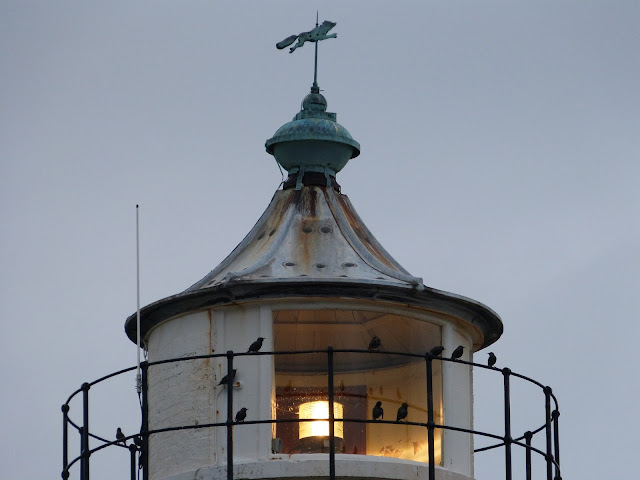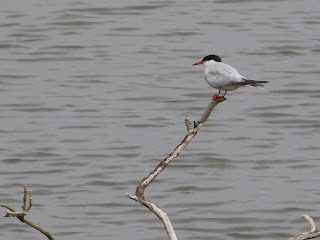 Before we got very far, we were greeted by a very handsome male pheasant which had alighted on a fallen tree trunk. Not the most 'exciting' sighting, but he was resplendent in his winter colours.
Before we got very far, we were greeted by a very handsome male pheasant which had alighted on a fallen tree trunk. Not the most 'exciting' sighting, but he was resplendent in his winter colours.We began on the woodland trail and it wasn't long before a flock of softly calling finch-sized birds flew overhead and settled in a nearby tree. They set to work on tweezering seeds out of tightly closed cases. It was a mixed flock of siskin and goldfinches. I am slowly becoming more familiar with the siskin this season, getting used to looking for their unique stripy-ness and their high pitched calls when it flight and perched. Reaching the end of the woodland trail, following an unidentified bird of prey (we never did get a good look at it), we spotted a mistle thrush perched on telephone wires in the neighbouring field. It has been a long while since I've seen one of these handsome birds.
We turned onto the fen trail and began the muddy walk towards Tower hide. We heard a great spotted woodpecker calling in the distance, eventually tracking it down to the top of the tallest branches in the woodland. Walking across large clearings like this always makes me notice Norfolk's big skies, and always makes me question why I would ever live anywhere else.
 A robin, dunnock and few blackbirds greeted us along the trail, but it was very quiet. Pausing at a clearing just before reaching the hide, I spotted what I am sure was a water vole swimming between patches of reed. All I could make out was little brown head above the water line, swimming completely silently and with almost no wake, I would have missed it had I not already been looking at something else in the same direction. Apart from this potentially exciting encounter, there was little action even looking out from Tower hide, with the exception of two majestic marsh harriers quartering the reed bed below.
A robin, dunnock and few blackbirds greeted us along the trail, but it was very quiet. Pausing at a clearing just before reaching the hide, I spotted what I am sure was a water vole swimming between patches of reed. All I could make out was little brown head above the water line, swimming completely silently and with almost no wake, I would have missed it had I not already been looking at something else in the same direction. Apart from this potentially exciting encounter, there was little action even looking out from Tower hide, with the exception of two majestic marsh harriers quartering the reed bed below.
Turning back to avoid too much mud, we headed for Fen hide. Unfortunately, there was little to see here either. We decided that all of the geese, ducks and waders must be at nearby Buckenham Marshes instead, so we headed back to the reception and jumped in the car. On the way, we spotted a young grey heron practicing its fishing skills and a marsh harrier bathing at the edge of a pool.
Wigeon, lots and lots of wigeon is what greeted us at Buckenham Marshes, all softly calling to each other in that charming whistle. A small flock of lapwing showed off their contrasting colours in the afternoon sun as they sailed past in the distance.
Perhaps there were fewer birds due to the unseasonably warm weather, perhaps they are just confused. One volunteer told me that another visitor had seen a marsh harrier building a nest.
To finish the day on another unusual sight, after we arrived home, we were visited by a male kestrel in the grounds of our flat in Norwich. He looked in excellent shape. We've never seen one this close to us before.


















































